Research Results
New Technology to Change the Future of Architecture and Civil Engineering
The world's first temperature-independent iron-based superelastic alloyFY2022
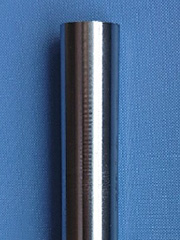
- Company: Furukawa Techno Material Co., Ltd.
Researcher: Omori Toshihiro, (Associate Professor, Graduate School of Engineering, Tohoku University) - Adaptable and Seamless Technology Transfer Program through Target-driven R&D (A-STEP)
- Industry-Academia Collaborative Phase: Seeds Development Type FS
- Development of Large-Scale Member of Iron-based Superelastic Alloys in Single-Crystalline Form for Maintaining the Function of Buildings after a Major Earthquake(2019-2020)
Superelastic alloys for seismic vibration control of structures
In recent years, there has been an increase in research on the use of superelastic (*1) alloys to create vibration control structures that suppress the residual deformation of buildings and bridges (i.e., the failure of structural members to restore to their original shape after an earthquake) after a major earthquake. The research group has succeeded in developing an iron-based superelastic alloy that shows excellent superelasticity from cryogenic temperatures (near absolute zero -273.15°C) to 200°C, with almost no temperature dependence of the strength properties. This superelastic alloy has not only potential applications in the Moon and Mars environments, which are subject to severe temperature changes, but also can be utilized to develop seismic vibration control systems in the building and civil engineering fields.
The work has been published in Science issued on August 14, 2020.
https://www.science.org/doi/10.1126/science.abc1590
∗1 Superelasticity
The property of a material to return to its original shape when a force is removed, even if a large deformation is induced.
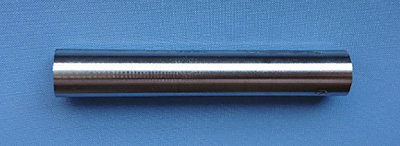
Fig.1 The newly developed iron-based superelastic alloy
Conventional superelastic alloys that do not restore their original shape at high temperatures
Metals that exhibit superelasticity, one of the shape memory properties, are called superelastic alloys, and Ti-Ni (titanium-nickel) alloys are commonly used for orthodontic wires and eyeglass frames. However, conventional superelastic alloys have the disadvantage that their deformation strength increases with rising temperature, making it difficult to restore the original shape after deforming. In the case of Ti-Ni alloys, the strength (stress) increases by approximately 6 MPa when temperature increases by 1°C. Therefore, even if the material composition is adjusted, the temperature range in which superelasticity can be practically utilized is limited to approximately -20°C to 100°C. Furthermore, Ti-Ni alloys have the following weaknesses: they are expensive, difficult to process and cut, and not applicable to complex shapes. In this context, the development of iron-based elastic alloys has been promoted as a new superelastic alloy to compensate for the above-mentioned disadvantages of Ti-Ni alloys.
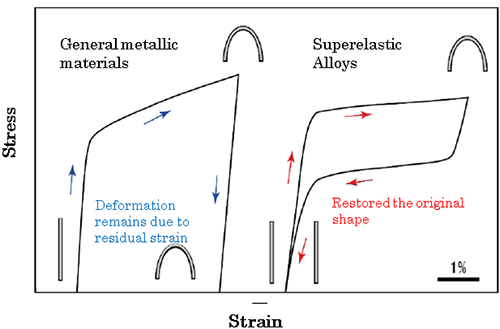
Fig.2 Schematic diagram of the relationship between strain and strength (stress) of general metallic materials vs. superelastic alloys
Development of superelastic alloys covering extraterrestrial temperature ranges
A feature of the newly developed iron-based superelastic alloy (consisting essentially of iron and containing manganese, aluminum, nickel and chromium) is that its strength (stress) hardly varies even when the temperature changes (Fig. 3). In addition, the temperature range in which the stress variation stays 50 megapascals (MPa) or lower is very wide (Fig. 4). Although such a temperature range is limited to approximately 8°C near room temperature in the practical Ti-Ni alloy, the range is approximately 400°C from cryogenic temperature in this iron-based superelastic alloy. This new alloy will cover the temperature range on Earth as well as in Moon and Mars environments. By adjusting the composition, it is also possible to obtain unusual properties of superelastic alloys that exhibit a tendency to decrease in strength at higher temperatures.
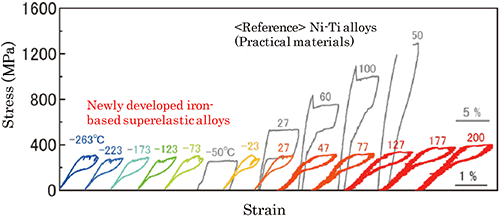
Fig. 3
Superelasticity of the newly developed iron-based superelastic alloy at temperatures between -263°C and 200°C. It is less affected by temperature changes than the Ti-Ni (titanium-nickel) alloy in practical use.
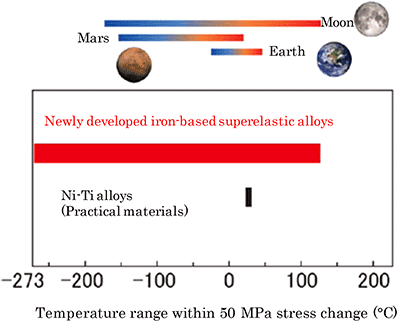
Fig. 4
Comparison of the utilizable temperature range between the iron-based superelastic alloy developed in this study and the Ti-Ni (titanium-nickel) alloy that is in practical use. The range where the stress change is within 50 MPa is shown. The upper part of the figure shows the temperature ranges of the Earth, Moon, and Mars.
Contributing to the construction, civil engineering, and space development fields by developing larger sizes based on heat treatment conditions discovered in FS
The newly developed iron-based superelastic alloy is composed of inexpensive raw materials, making it easy to use as a large member. Therefore, the new alloy is expected to be applied to vibration control systems, etc. that can reduce the damage to buildings caused by earthquakes and enable the continued use of buildings afterwards. Since the Hyogo-ken Nanbu Earthquake, many buildings have escaped collapsing even in the event of a massive one, but there is still the problem of residual deformation, which can lead to increased damage in aftershocks or difficulty in continued use, forcing reconstruction. By using the new alloys as part of buildings and highway piers, residual deformation can be suppressed through origin restoring force even when subjected to large deformation due to earthquakes. In addition, these are highly versatile in that their mechanical properties are not affected by changes in ambient temperature, and their use is not limited by regional or seasonal temperature changes. In the future, in order to apply this technology to vibration control structures in the fields of architecture and civil engineering, a single crystallization technique by heat treatment will be established to manufacture large members, followed by the performance evaluation of superelasticity.
This new alloy is also attracting attention because it is the first alloy in the world to exhibit extreme superelasticity in a wide temperature range from cryogenic up to 200°C. In Moon, Mars, and asteroid exploration projects planned by Japan, the U.S., and other countries, such iron-based superelastic alloys, which show excellent elasticity even in an extraterrestrial environment with drastic temperature changes, may be used as shock- and vibration-absorbing materials.
